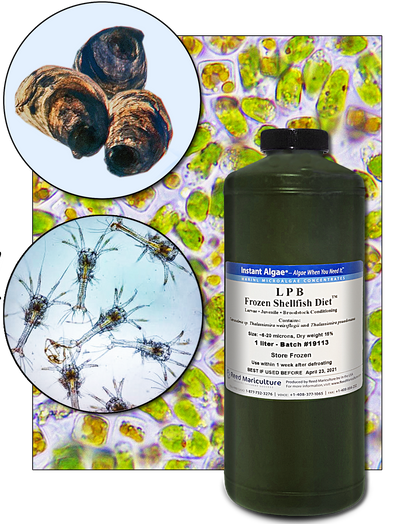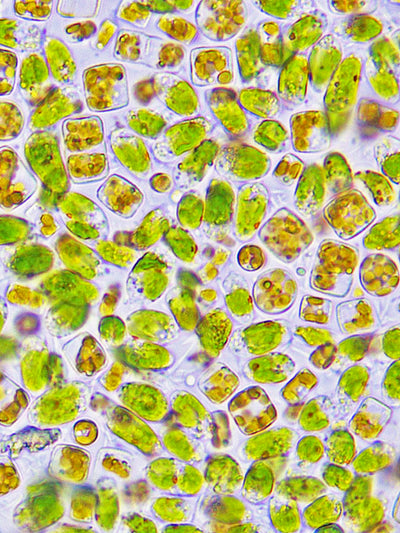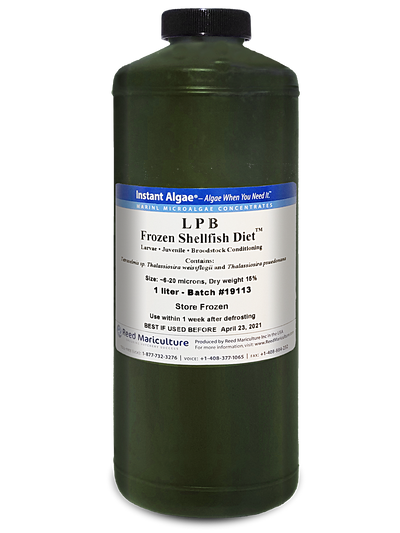


LPB™ FROZEN SHELLFISH DIET®
For Larvae, Post-larvae and Broodstock Bivalves and Larval Shrimp, LPB is a frozen, whole-cell concentrate of Tetraselmis, Thalassiosira weissflogii, Thalassiosira pseudonana, and Schizochytrium
LPB Frozen ShellFish Diet for Bivalves Technical Data Sheet (PDF)
Showing information for Bivalve Larvae, Spat and Broodstock below...
Product Description
Applications & Benefits
Directions & Feeding
Directions
- Defrost overnight in a refrigerator.
- When water is circulated with a centrifugal pump, such as with an upweller, add in front of the pump intake and the pump will disperse the algae cells.
- When feeding into open tanks or header tanks, pre-dilute the algae 10:1 with system water.
- Add system water to a small bucket.
- Add LPB Shellfish Diet and stir.
- DO NOT BLEND; it is unnecessary and may damage the algae cells.
- Pour into larvae tank or spat.
- Pouring through a 20–micron screen can improve dispersion.
- Feed according to the table below. Adjust dosage to meet the needs of your hatchery and larvae.
- Refrigerate bottle when not in use.
- Use within 8 days of defrosting.
Typical Feed Rates
Bivalve Larvae Feed Chart
Feed according to shell length. Shell length on a given day may vary between production runs.
Daily Feed Rates per million larvae, for Crassostrea virginica (from FAO protocol)
| Day | Mean shell length | LPB SHELLFISH DIET (ml) | Liters of live Isochrysis (4x10^6 cells/ml) |
|
|---|---|---|---|---|
| 2 | 75 | N/A | = | N/A |
| 3 | 95 | N/A | = | N/A |
| 4 | 100 | N/A | = | N/A |
| 5 | 115 | N/A | = | N/A |
| 6 | 130 | N/A | = | N/A |
| 7 | 145 | 3.3 | = | 5.1 |
| 8 | 160 | 4.2 | = | 6.6 |
| 9 | 190 | 6.0 | = | 9.5 |
| 10 | 220 | 7.9 | = | 12.4 |
| 11 | 240 | 9.2 | = | 14.4 |
| 12 | 260 | 10.4 | = | 16.3 |
| 13 | 270 | 11.0 | = | 17.3 |
| 14 | 280 | 11.7 | = | 18.3 |
Spat
Feed By Live Weight
- 0.5ml LPB SHELLFISH DIET per gram live weight of spat per day
- Works for all sizes of spat
– OR –
Feed by Seed Count and Size
(Feeding 1 million Oyster Spat; based on FAO manual, p. 137, Table 14)
| Length (mm) | LPB SHELLFISH DIET feed per day |
|---|---|
| 0.3 | 4.2 ml |
| 0.5 | 30 ml |
| 1.0 | 130 ml |
| 2.0 | 1.0 Liters |
| 3.0 | 3.0 Liters |
Feeding Broodstock Conditioning and Fattening
Typical Broodstock Feed Rates:
0.02–0.04 ml LPB SHELLFISH DIET per gram wet meat weight per day
-OR-
0.2–0.7 ml LPB SHELLFISH DIET per adult animal per day (depending on feed ration and size*)
*The required food ration for conditioning is based on the meat weight of the adults. It is usually between 2 and 4% of the mean dry meat in dry weight of algae fed per day. This is approximately equivalent to 0.02–0.04 ml LPB SHELLFISH DIET per gram of wet meat weight.
Spat Trial Data:

Carlsbad Aquafarms (August 13, 2019 to Sept 3, 2019)
Fed 0.15ml/gram per day
Live feed: Iso/Pav mix
Storage & Technical Data
| Packaging | 1 liter bottle |
|---|---|
| Storage | 2 years shelf life when frozen Use within 8 days of defrosting |
| Tips | Keep frozen before defrosting Refrigerate after defrosting |
| Physical Properties | |
|---|---|
| Appearance | Viscous green-brown concentrate |
| Algal Cell Size | 4.5–15 microns |
| Cell Density | ~1 Billion cells per ml |
| Algal Biomass | 150g Dry Biomass/L |
| Composition of Dry Algal Biomass (Typical) | |
|---|---|
| Protein | 52% |
| Lipids | 10.5% |
| DHA (% of Lipids) | 8.0% |
| EPA (% of Lipids) | 9.5% |
| Carbohydrate | 16.0% |
| Ash | 21.0 % |
| Composition of Liquid Product | |
|---|---|
| Protein | > 7.8% |
| Lipids | > 1.5% |
| Carbohydrate | > 2.4% |
| Ash | < 8.5% |
| Moisture | < 85% |
| Microbial Specification | |
|---|---|
| Coliform Bacteria | < 0.3 mpn/ml |
| Salmonella | Negative |
| Known pathogenic marine bacteria | Negative |
Customer Reviews
Related products

SHELLFISH DIET 1800®
A unique mix of five marine microalgae - Isochrysis, Pavlova, Tetraselmis, Thalassiosira weissflogii and Thalassiosira pseudonana species that have demonstrated success with a wide variety of marine and freshwater shellfish, including: oysters, clams, mussels, scallops, and crustaceans.

